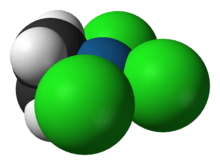P. G. Owston
Philip George Owston[1] (January 1921 – September 2001) was a British chemist and crystallographer for whom the Owston Islands (66°22′59″S 66°6′0″W)[2] in Antarctica are named.[3] The Owston Islands lie within the region claimed by the United Kingdom (British Antarctic Territory), Argentina (Argentine Antarctica), and Chile (the Antártica commune in Antártica Chilena Province).[4] They are a group of small islands lying 1 nautical mile (1.9 km) west of Darbel Islands in Crystal Sound, and they were named by the United Kingdom Antarctic Place-Names Committee.[3] Owston was born in Saltburn-by-the-Sea, Yorkshire, England during January 1921 as the son of Edward Owston and Margaret Smith. He died in Watford, Hertfordshire, England in September 2001.[1]

Owston's crystallography work included the determination of the structure of Zeise's salt,[5][6] the anion of which is shown at right. Zeise's salt, K[PtCl3(η2-C2H4)]·H2O, was reported in 1831[7] and was one of the first organometallic compounds ever discovered. However, the nature of the platinum to ethylene bond in the compound was not understood until the development of the Dewar–Chatt–Duncanson model in the 1950s.[8][9][10] The space-filling model from the Owston crystal structure clearly shows that it is an organometallic species as there is direct bonding between the platinum metal centre (in blue) and the two carbon atoms of the ethylene ligand (in black).
In 1964, Owston wrote an article in New Scientist[11] on the use of electron spin resonance spectroscopy in chemistry.
References
- Ouston, Roger J. (2003). "Entries 1769-1771". A Directory of Ouston and Owston Families. Roger J. Ouston.
- "Place-Name Listing". United Kingdom Antarctic Place-Names Committee. Archived from the original on May 7, 2008. Retrieved January 9, 2011.
- National Geospatial-Intelligence Agency. "Owston Islands: Antarctica". Geographical Names (geographic.org). Retrieved January 9, 2011.
- Beck, Peter J. (1986). The International Politics of Antarctica. Routledge. pp. 119–120. ISBN 978-0-7099-3239-0.
- Black, M; Mais, R. H. B.; Owston, P. G. (1969). "The crystal and molecular structure of Zeise's salt, KPtCl3.C2H4.H2O". Acta Crystallogr. B. 25 (9): 1753–1759. doi:10.1107/S0567740869004699.
- Jarvis, J. A. J.; Kilbourn, B. T.; Owston, P. G. (1971). "A Re-determination of the Crystal and Molecular Structure of Zeise's salt, KPtCl3.C2H4.H2O". Acta Crystallogr. B. 27 (2): 366–372. doi:10.1107/S0567740871002231.
- Zeise, W. C. (1831). "Von der Wirkung zwischen Platinchlorid und Alkohol, und von den dabei entstehenden neuen Substanzen". Annalen der Physik (in German). 97 (4): 497–541. Bibcode:1831AnP....97..497Z. doi:10.1002/andp.18310970402.
- Mingos, D. Michael P. "A Historical Perspective on Dewar's Landmark Contribution to Organometallic Chemistry". J. Organomet. Chem. 635 (1–2): 1–8. doi:10.1016/S0022-328X(01)01155-X.
- Winterton, N. (2002). "Some Notes on the Early Development of Models of Bonding in Olefin-Metal Complexes". In Leigh, G. J.; Winterton, N. (eds.). Modern Coordination Chemistry: The Legacy of Joseph Chatt. RSC Publishing. pp. 103–110. ISBN 978-0-85404-469-6.
- Astruc, Didier (2007). Organometallic Chemistry and Catalysis. Springer. pp. 41–43. ISBN 978-3-540-46128-9.
- Owston, P. G. (November 5, 1964). "Electron Spin Resonance". New Scientist. 24 (416): 373–377.